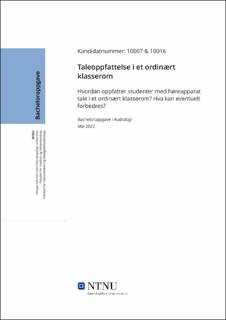| dc.contributor.advisor | Vinay, Sandhya | |
| dc.contributor.author | Næss, Lise | |
| dc.contributor.author | Kularas, Abirami | |
| dc.date.accessioned | 2022-07-21T17:19:32Z | |
| dc.date.available | 2022-07-21T17:19:32Z | |
| dc.date.issued | 2022 | |
| dc.identifier | no.ntnu:inspera:107342744:34116695 | |
| dc.identifier.uri | https://hdl.handle.net/11250/3007587 | |
| dc.description.abstract | Formål: Menneskets hovedvei til kommunikasjon kommer via det viktigste talesignalet vi
hører. Tale er viktig for kommunikasjon, og kan bidra til å påvirke undervisning og trivsel på
skolen. Å oppfatte tale er viktig for klasseromsundervisning, men også for å delta i felleskapet
og føle seg inkludert. Dermed er studiens formål å undersøke hvordan studenter med nedsatt
hørsel oppfatter tale i et ordinært klasserom.
Metode og informanter: For å undersøke temaet er det blitt gjennomført en kvalitativ studie
med semistrukturert intervju av fire personer mellom 18-27 år. Informantene ble innhentet via
rekruttering på Facebook, Instagram og bekjente. Alle bruker høreapparater og studerer ved
universiteter i Trøndelag. For å analysere datamaterialene ble det benyttet en “systematisk
tekstkondensering”.
Resultat: I resultatet kommer det frem forskjellige opplevelser knyttet til taleoppfattelse i
klasseromsundervisning. Funn viser at tre av fire anvender hjelpemidler i form av Roger Pen,
bordmikrofon og høyttaler forsterkere. Samtidig, ble det funnet at samtlige anvender
kommunikasjonsstrategier i form av munnavlesning og plassering for å bedre
taleoppfattelsen. Tre av fire opplever at stemmen og språket til talspersonen har en
påvirkning. Dette i form av lys stemme, mørk stemme, ulikt språk eller dialekt. Studien viser
også at samtlige har hatt ulikt perspektiv når det gjelder hensyn fra lærere. Det kommer også
frem at informantene ønsker bedre tilrettelegging i klasserom.
Konklusjon: Det konkluderes med at taleoppfattelse avhenger av hjelpemidler og
tilrettelegging. Dette innebærer at lærere må anvende hjelpemidler hyppigere. Utstyr knyttet
til tilrettelegging må utbedres for at informantens taleoppfattelse kan forbedres. | |
| dc.description.abstract | Objectives: Human main path to communication are speech signals we are hearing. Speech is
important for communication and can help influence teaching and well-being at school.
Perceiving speech is important for classroom teaching, as well as for participation in the
community and feel included. The purpose of this study is to investigate how students with
hearing loss identify speech in an ordinary classroom.
Methods and participants: To investigate the topic, a qualitative study has been conducted
with a semi-structured interview. The participants for the interview were four persons
between the age of 18 and 27. The participants were recruited through social media and
friends. All the participants use hearing aid and studies at universities in Trøndelag. A
systematic text condensation was used to analyze the data materials.
Results: The result is various experiences related to speech perception in classroom teaching.
The results shows that three out of four uses aids in the form of Roger Pen, table microphone
and speaker amplifiers. At the same time, it was found that some participants use different
alternatives as communication strategies in the form of oral reading and placement to improve
speech perception. Three out of four experience that the voice and language of the
spokesperson have an impact. This in the form of light voice, dark voice, and different
languages or dialects. The study also shows that they have different perspectives when it
comes to consideration from teachers. It also appears that the informants want better
facilitation in classrooms.
Conclusions: The conclusion is that speech perception depends on aids and facilitation. This
means that teachers must use aids more frequently and equipment related to facilitation. This
must improve so that the informant’s speech perception can be improved. | |
| dc.language | nob | |
| dc.publisher | NTNU | |
| dc.title | Taleoppfattelse i et ordinært klasserom | |
| dc.type | Bachelor thesis | |
